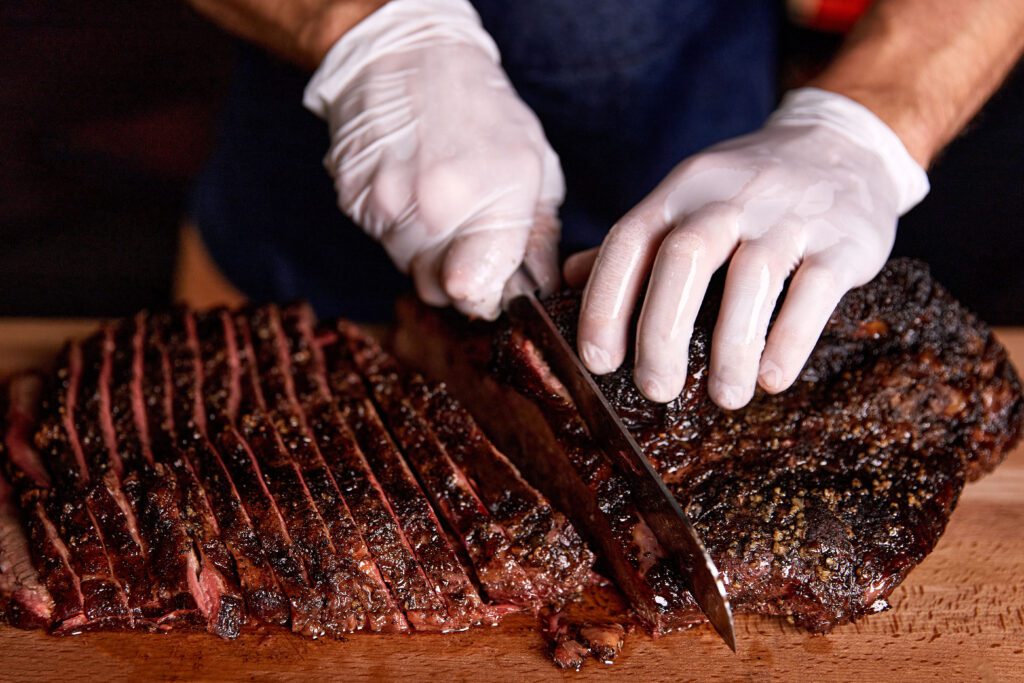The final cooking stage is resting or holding the Brisket after it has been taken out of the smoker. I wanted to learn everything I could about resting Brisket because this is a vital stage that can make or break your Brisket. Even after the meat has been removed from the smoker, it will continue to cook.
The additional benefit of holding Brisket for a long time is that any tight places on the meat will be fixed by carry-over cooking.
Too Soon for Brisket to Be Finished
When someone says their Brisket is “done,” they refer to the softness stage, and Brisket typically cooks to a doneness of 195 to 205°F.
I prefer to feel the tenderness of the probe. There should be no resistance as you insert your probe into the meat.
Typically, Brisket is done when it reaches 205°F (in both the fatty and the lean portions) and feels probing and tender.
That said, even if probing tenderness is attained, and the Brisket is considered “done,” many forget that it must rest before being cut up.
Brisket needs around 2-3 hours to cool down to slicing temperatures, typically around 165°F.
The entire Brisket measured 204–205°F in the point and flat when I took the photo up top. But I could still feel some tightness in a few places, and I was aware that this Brisket would benefit from resting overnight.
Why Brisket Should Be Resting
Resting is a crucial step that is frequently missed while smoking a brisket. Collagen, which makes up most of the connective tissues in Brisket, is being denaturized, which can help us understand what is happening inside the beef.
Brisket’s connective tissues take 140°F before they start to disintegrate. At about 160°F, collagen also begins to melt.
For this 160-205°F window, the Brisket must be heated slowly and gradually for several hours to break down the connective tissues.
The Brisket should be rested, covered, or uncovered.
Wait to remove the meat’s wrapper after you’ve taken the Brisket out of the pan. The Brisket should stay hot for several hours if you let it sit in its wrapping and put it in a dry cooler lined with a towel. While planning, you should factor in the Brisket’s capacity to maintain heat for several hours. When you don’t know when the smoked Brisket will be done, it might be challenging to plan to serve it for lunch or supper. With a three to four-hour resting period, your Brisket can be prepared hours before your guests come and still be hot enough to carve at 150°F.
What Happens if the Brisket Isn’t Resting?
The Brisket will only be tender and juicy if you rest it. The Brisket will continue to cook for a few more hours after being removed from the smoker. Because the meat is tenderizing throughout this resting period, it’s a crucial step. The flesh can reabsorb moisture throughout the resting period. The Brisket will be chewy and dry out quickly if you omit this step.
Does Rest Stop Brisket From Being Dry?
The Brisket won’t dry out if given time to rest. The Brisket will reabsorb moisture by remaining in its wrapper for a few hours, making the meat luscious. The heart will lose steam if cut too soon after cooking, and fluids will run onto the cutting board. The Brisket may dry if you wait too long to serve it after cutting. Pour the gravy over the sliced Brisket.
The importance of resting Brisket
Resting is a crucial step that is frequently missed while smoking a brisket. Collagen, which makes up most of the connective tissues in Brisket, is being denaturized, which can help us understand what is happening inside the beef.
Brisket’s connective tissues take 140°F before they start to disintegrate. At about 160°F, collagen also begins to melt.
For this 160-205°F window, the Brisket must be heated slowly and gradually for several hours to break down the connective tissues. Collagen and other connective tissues turn into gelatin during this time. Gelatin can absorb up to ten times its weight in liquid due to its hygroscopic nature.
Simply put, the gelatin needs time to absorb the moisture released by the protein fibers and redistribute it throughout the Brisket. The juices would run out of the Brisket if you cut into it after it has finished cooking because it wouldn’t have had time to gelatinize.
The Brisket should rest for how long?
Resting a brisket is very different from resting more minor cuts of meat, such as pork chops, steaks, or chicken breast. While a brisket takes an hour of rest before serving, smaller pieces merely need a few minutes of room-temperature rest.
Cooked Brisket should rest for at least an hour but at most two hours, regardless of the cooking method (smoking, roasting, etc.). The Brisket begins to cool at room temperature after more than a few hours, and warming it could make it dry.
If heat retention is a concern, you can cover the Brisket in foil and tent it loosely with it or put it in an empty cooler.
Note: Brisket shouldn’t be left to rest overnight as it will grow dangerous bacteria.
CONCLUSION:
For better, tastier results, smoking Brisket demands a lot of patience, expertise, and knowledge to prepare Brikset properly. The juiciest and most flavorful meat will be available to you and your family if you properly rest your Brisket.
And if you find this article helpful or have any suggestions, feel free to reach us.

